Rapid, futile K+ cycling and pool-size dynamics define low-affinity potassium transport in barley
- PMID: 16815955
- PMCID: PMC1533945
- DOI: 10.1104/pp.106.082701
Rapid, futile K+ cycling and pool-size dynamics define low-affinity potassium transport in barley
Abstract
Using the short-lived radiotracer 42K+, we present a comprehensive subcellular flux analysis of low-affinity K+ transport in plants. We overturn the paradigm of cytosolic K+ pool-size homeostasis and demonstrate that low-affinity K+ transport is characterized by futile cycling of K+ at the plasma membrane. Using two methods of compartmental analysis in intact seedlings of barley (Hordeum vulgare L. cv Klondike), we present data for steady-state unidirectional influx, efflux, net flux, cytosolic pool size, and exchange kinetics, and show that, with increasing external [K+] ([K+]ext), both influx and efflux increase dramatically, and that the ratio of efflux to influx exceeds 70% at [K+]ext > or = 20 mm. Increasing [K+]ext, furthermore, leads to a shortening of the half-time for cytosolic K+ exchange, to values 2 to 3 times lower than are characteristic of high-affinity transport. Cytosolic K+ concentrations are shown to vary between 40 and 200 mm, depending on [K+]ext, on nitrogen treatment (NO3- or NH4+), and on the dominant mode of transport (high- or low-affinity transport), illustrating the dynamic nature of the cytosolic K+ pool, rather than its homeostatic maintenance. Based on measurements of trans-plasma membrane electrical potential, estimates of cytosolic K+ pool size, and the magnitude of unidirectional K+ fluxes, we describe efflux as the most energetically demanding of the cellular K+ fluxes that constitute low-affinity transport.
Figures
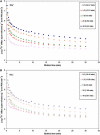
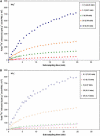
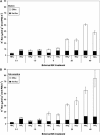


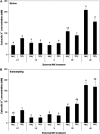
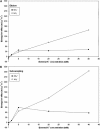
Similar articles
-
Cytosolic potassium homeostasis revisited: 42K-tracer analysis in Hordeum vulgare L. reveals set-point variations in [K+].Planta. 2003 Aug;217(4):540-6. doi: 10.1007/s00425-003-1032-5. Epub 2003 May 1. Planta. 2003. PMID: 12728317
-
Alleviation of rapid, futile ammonium cycling at the plasma membrane by potassium reveals K+-sensitive and -insensitive components of NH4+ transport.J Exp Bot. 2008;59(2):303-13. doi: 10.1093/jxb/erm309. Epub 2008 Jan 17. J Exp Bot. 2008. PMID: 18203690
-
Regulation and mechanism of potassium release from barley roots: an in planta 42K+ analysis.New Phytol. 2010 Dec;188(4):1028-38. doi: 10.1111/j.1469-8137.2010.03436.x. Epub 2010 Aug 20. New Phytol. 2010. PMID: 20731780
-
The nitrogen-potassium intersection: membranes, metabolism, and mechanism.Plant Cell Environ. 2017 Oct;40(10):2029-2041. doi: 10.1111/pce.12671. Epub 2016 Jan 18. Plant Cell Environ. 2017. PMID: 26524711 Review.
-
Potassium homeostasis and signalling: from the whole plant to the subcellular level.Quant Plant Biol. 2025 May 8;6:e13. doi: 10.1017/qpb.2025.10. eCollection 2025. Quant Plant Biol. 2025. PMID: 40391039 Free PMC article. Review.
Cited by
-
A pharmacological analysis of high-affinity sodium transport in barley (Hordeum vulgare L.): a 24Na+/42K+ study.J Exp Bot. 2012 Apr;63(7):2479-89. doi: 10.1093/jxb/err419. Epub 2012 Jan 20. J Exp Bot. 2012. PMID: 22268152 Free PMC article.
-
NH4+-stimulated and -inhibited components of K+ transport in rice (Oryza sativa L.).J Exp Bot. 2008;59(12):3415-23. doi: 10.1093/jxb/ern190. Epub 2008 Jul 24. J Exp Bot. 2008. PMID: 18653690 Free PMC article.
-
Non-reciprocal interactions between K+ and Na+ ions in barley (Hordeum vulgare L.).J Exp Bot. 2008;59(10):2793-801. doi: 10.1093/jxb/ern139. Epub 2008 Jun 18. J Exp Bot. 2008. PMID: 18562445 Free PMC article.
-
Determination of optimal NH4+/K + concentration and corresponding ratio critical for growth of tobacco seedlings in a hydroponic system.Front Plant Sci. 2023 Jul 11;14:1152817. doi: 10.3389/fpls.2023.1152817. eCollection 2023. Front Plant Sci. 2023. PMID: 37496856 Free PMC article.
-
The transcriptome variations of Panaxnotoginseng roots treated with different forms of nitrogen fertilizers.BMC Genomics. 2019 Dec 24;20(Suppl 9):965. doi: 10.1186/s12864-019-6340-7. BMC Genomics. 2019. PMID: 31874632 Free PMC article.
References
-
- Adams F (1971) Soil solution. In EW Carson, ed, The Plant Root and Its Environment. University Press of Virginia, Charlottesville, VA, pp 441–481
-
- Apse MP, Blumwald E (2002) Engineering salt tolerance in plants. Curr Opin Biotechnol 13: 146–150 - PubMed
-
- Asher CJ, Ozanne PG (1966) Growth and potassium content of plants in solution cultures maintained at constant potassium concentrations. Soil Sci 103: 155–161
-
- Ashley MK, Grant M, Grabov A (2006) Plant responses to potassium deficiencies: a role for potassium transport proteins. J Exp Bot 57: 425–436 - PubMed
Publication types
MeSH terms
Substances
LinkOut - more resources
Full Text Sources
Medical

